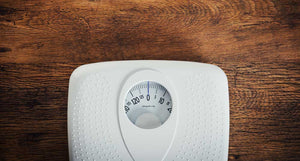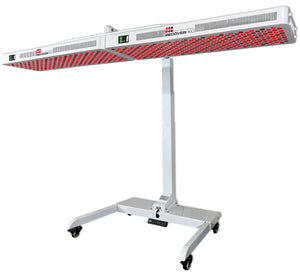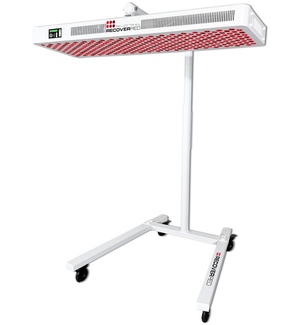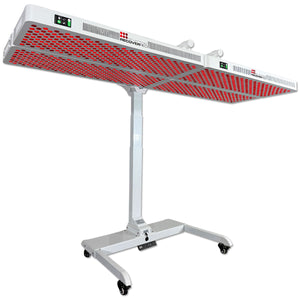
Can You Use Red Light Therapy to Lose Weight? Separating Fact from Fiction
In recent years, red light therapy (RLT) has emerged as a novel approach for effective weight loss. Also known as low-level laser therapy (LLLT) or infrared light therapy, this technology promises a non-invasive fat removal treatment that sounds almost too good to be true. The problem is, it might be just that.
Red light therapy weight loss is indeed a growing trend, and the fact that RLT has proven so effective at treating other problems gives weight to claims that it can help burn stubborn fat deposits that seem immune to diet and exercise. However, this enthusiasm is met with skepticism by many in the health and scientific community, who feel the evidence simply isn’t there.
In this article, we’ll attempt to shed some (red) light on RLT, exploring its potential benefits, limitations, and the science behind its use for weight loss.
What is Red Light Therapy?

More importantly, RLT is a non-invasive and pain-free treatment option that people can do right in their homes, providing they purchase their own red light device. As RLT becomes more and more popular, we will undoubtedly discover that it has benefits for many different health problems. What remains to be seen is if fat loss is one of those issues.
How Does Red Light Therapy Work?
The foundational principle of red light therapy is its capacity to energize the mitochondria, which you might remember from grade school is the “powerhouse of the cell.” This stimulation is thought to enhance cellular function across the body, facilitating processes such as skin repair, new cell growth, and rejuvenation.
Specifically, red light therapy has been shown to increase collagen production, a critical protein that provides skin with its structure and elasticity. By stimulating collagen and increasing blood circulation, RLT may contribute to healthier, more vibrant skin. As we’ll see later on, this may be one of the big reasons why red light therapy for fat loss is becoming a growing trend.
Proven Benefits of Red Light Therapy
Red light therapy offers many health benefits beyond its controversial use in weight loss. Its proven advantages span from enhancing skin health, improving muscle recovery, and supporting mental well-being. Here's a deeper dive into some of these benefits:
- Skin Health and Anti-Aging - RLT boosts collagen production, which is crucial for maintaining the skin's elasticity and reducing the appearance of fine lines and wrinkles. Increased collagen and enhanced blood circulation contribute to healthier, more resilient skin, helping combat signs of aging.
- Muscle Recovery and Athletic Performance - Athletes and fitness enthusiasts may find RLT beneficial for muscle recovery. RLT can alleviate muscle fatigue and soreness after intense physical activity by reducing inflammation and increasing blood flow. This accelerates recovery, allowing for more consistent and effective training sessions.
- Joint Pain and Inflammation Reduction - Individuals suffering from joint pain, including conditions like arthritis, may experience relief through RLT. The therapy's anti-inflammatory effects can reduce pain and improve mobility, enhancing the quality of life for those affected by chronic joint conditions.
- Improved Mental Health - Emerging research suggests RLT has a lot of potential for treating depression and anxiety. By modulating brain activity and enhancing mitochondrial function, RLT may offer a non-pharmacological option to improve mood and alleviate symptoms of mental health disorders.
- Wound Healing and Tissue Repair - RLT accelerates the body's natural healing processes, making it a valuable tool for reducing recovery times from injuries and surgeries. This is particularly relevant for skin wounds and soft tissue injuries, where enhanced cell regeneration can lead to faster and more efficient healing.
- Support for the Cardiovascular System - By improving blood circulation and reducing inflammation, RLT can offer ancillary benefits to the cardiovascular system. This includes potential reductions in blood pressure and improved heart health.
- Enhanced Bone Density - Preliminary studies indicate that RLT may positively impact bone density. This could be particularly beneficial for individuals at risk of osteoporosis, offering a non-invasive means to support bone health.
How They Use Red Light Therapy For Weight Loss

It’s also important to remember that red light therapy stimulates the mitochondria within cells, boosting their energy production and potentially leading to various health benefits.
For instance:
- Mitochondria are responsible for converting nutrients from the food we eat. The efficiency and effectiveness of this process can influence how much energy is used by the body and how much is stored as fat.
- Mitochondria play a direct role in burning fat by oxidizing fatty acids during physical activity and rest. Increasing the activity of mitochondria can enhance the body's ability to burn fat as a fuel source, contributing to weight loss.
- The number and functionality of mitochondria in cells can affect the basal metabolic rate), which is the amount of energy expended while at rest. A higher BMR means that the body uses more energy for basic functions such as breathing, circulation, and cell production, which can contribute to weight loss or maintenance.
Despite its growing popularity, the precise mechanisms by which RLT aids in fat loss remain widely debated within the scientific community. Some researchers suggest that the therapy's effectiveness in fat reduction could be attributed to the mitochondrial processes outlined above. So, rather than “shrinking fat cells,” it simply enhances the efficiency of a process our bodies perform naturally.
Claims About Using Red Light Therapy for Weight Loss

For example, certain studies have reported modest reductions in waist circumference, hips, and thighs among participants undergoing RLT. For instance, a study observed a significant decrease in waist, hip, and thigh measurements over a 2-week period, suggesting potential benefits for body contouring.
However, there is limited data on the long-term effects of RLT for weight loss, and the clinical relevance of the observed reductions in body measurements remains uncertain. Therefore, all we can say right now is that more comprehensive and long-term studies are needed to ascertain the true efficacy of RLT in weight management.
Red Light Therapy’s Effect on Fat Cells
Notwithstanding the debate over its impact on weight loss, red light therapy is believed to influence fat cells by stimulating them to release their stored contents, thereby reducing their size and improving body contour.
More importantly, some studies have explored the effects of RLT on hormones like leptin and ghrelin, which play crucial roles in appetite regulation and energy metabolism. These findings suggest that red light therapy could indirectly support weight loss by influencing these hormonal pathways, especially when combined with regular exercise.
In the end, because RLT has so few side effects, there is (at this moment) no harm in adding it to one’s current weight loss routine.
Implementing Red Light Therapy
Incorporating red light therapy into your wellness routine can be an enriching experience, potentially offering a variety of health benefits. Whether you're looking into RLT for skin health, muscle recovery, or as a supplemental approach to weight management, understanding how to implement it effectively is crucial.
Here are some tips on how to make sure you get the right treatment and the right device:
- Research Wavelengths - The effectiveness of RLT largely depends on the wavelengths of light used. Most research supports the use of specific red and near-infrared wavelengths, typically around 660nm for red light and 850nm for near-infrared.
- Consider Device Power and Coverage - The power output of an RLT device influences its effectiveness. Higher power devices can deliver more energy, potentially providing benefits in shorter durations. Additionally, the size of the device affects the area of your body that can be treated at one time. Larger panels can treat broader areas, such as the back or chest, while smaller devices may be better suited for targeted treatments, like facial skin or specific joints.
- Portability - If you lead a busy lifestyle, consider the portability and ease of use of the RLT device. Handheld units offer the convenience of use anywhere, while larger panels may require a dedicated space for treatment sessions.
- Safety Features - Look for devices with built-in safety features, such as auto-shutoff timers, to ensure a safe and comfortable experience when using them at home
- Consult with a Healthcare Professional - Before starting RLT, it’s advisable to speak with a healthcare provider, especially if you have underlying health conditions or specific concerns. They can offer guidance tailored to your health profile and objectives.
- Start with Manufacturer Recommendations - Begin your RLT journey by following the manufacturer's guidelines for use, including session duration and frequency. Most devices come with instructions on how to achieve the best results.
- Adjust Based on Your Needs - As you become more familiar with how your body responds to RLT, you may find it beneficial to adjust the duration or frequency of your sessions. Some individuals may see improvements with daily use, while others may benefit from less frequent sessions.
- Stay Updated on Research - The field of red light therapy is continually evolving, with new studies and evidence emerging regularly. Staying informed about the latest research can help you optimize your use of RLT and potentially discover new information about red light fat loss treatments.
The Verdict: Red Light Therapy and Weight Loss

In conclusion, while red light therapy may offer a range of health benefits, its effectiveness as a weight loss solution remains uncertain. The available evidence suggests that any impact on weight loss is minimal and best viewed as a complementary treatment rather than a standalone solution. Those considering red light therapy to lose weight should consult with a healthcare provider to discuss the potential benefits and drawbacks in the context of their individual health needs and goals.
Ultimately, adopting a holistic approach that includes a balanced diet, regular physical activity, and stress management remains the cornerstone of effective weight loss and overall well-being. Still, adding RLT to your routine is unlikely to do any harm, and may provide you with the mitochondrial benefits to accelerate your fat loss!
Sources and Studies
https://www.medicalnewstoday.com/articles/red-light-therapy-for-weight-loss#red-light-therapy-and-weight-loss
https://pubmed.ncbi.nlm.nih.gov/31473867/
https://pubmed.ncbi.nlm.nih.gov/20014253/
https://pubmed.ncbi.nlm.nih.gov/23355338/
https://pubmed.ncbi.nlm.nih.gov/22468172/
https://www.ncbi.nlm.nih.gov/pmc/articles/PMC4928454/
https://pubmed.ncbi.nlm.nih.gov/22362380/




